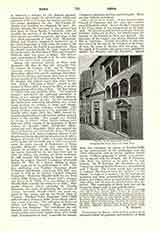

UNIVERSITY OF SIENA.—The earliest notices of an advanced school (of grammar and medicine) at Siena go back to 1241. In 1246 the Emperor Frederick II compelled the Sienese students at Bologna to abandon that city, which was hostile to him, and this fact must have contributed to enlarge the school of Siena, which then had celebrated professors of law (Pepo), of grammar (Magister Tebaldus, Hoannes Mordentis), of medicine (Petrus Yspanus). In 1252 the institution received from Pope Innocent IV the usual privileges for its professors and students. He granted the “University of Masters and Doctors regent at Siena and of their scholars studying in the same” together with their bedels an exemption from certain city taxes, and appointed the bishop as their conservator. In 1275 and 1285 the Commune of Siena, by its own authority, without regard either to the pope or to the emperor, decided to enlarge the studium into a studium generale. Nevertheless, it remained incomplete; but through the emigration from Bologna of professors and students in 1321 it received an unexpected increase, and then had twenty-two professors—seven of Roman law, five of canon law, two of medicine, two of philosophy, one of notarial science, the others of grammar, i.e., of literature and the interpretation of the classics. But after three years a great number of the professors and the scholars departed, either because peace had been established at Bologna, or because Siena could not obtain from the Holy See the necessary privileges for a real studium generale. In 1397, however, Siena obtained a Bull from Charles IV, which, after declaring that the studium had once been flourishing but had now sunk into obscurity, proceeds to confer upon it de novo the privileges of a studium generale. As early as 1386 we find a chair for the interpretation of Dante. In 1404 Bishop Marmille instituted the Collegio della Sapienza for poor students. In 1408 Gregory XII confirmed the privilege granted by Charles IV, and established a faculty of theology.
Among the professors of the fourteenth century mention should be made of the jurists, Dino del Garbo, Neri Pagliaresi, Federico Petrucci, Pietro Ancharano, Ubaldo degli Ubaldi, Tommaso Corsini; the physicians, Ugo Benzi and Riccardo da Parma (oculist); the grammarians, Nofrio and Pietro d’Ovile. Instruction was also given in mathematics and in astrology, in which latter study Guido Bonatti and Cecco d’Ascoli were famous. In the fifteenth century the following professors obtained celebrity: Nicolo de Tudeschi (il Panormitano), Francesco Accolti, and Mariano Soccini in law; Jacopo da Forli and Alessandro Sermoneta in medicine; Francesco Filelfo, the theologian Francesco della Rovere (afterwards Pope Sixtus IV), and Agostino Dati in literature. It should also be noted that Siena was conservative in letters as well as in art, for which reason Humanism was not able to obtain a foothold. Among the professors of the early sixteenth century were the jurist Claudio Tolomei, and the humanists Eurialo Ascolano and Jacopo Griffoli.
After Siena had come under the Medici, these princes used every effort to promote its prosperity. Among its famous jurists were Silvio Spannocchi and Francesco Accarigi; but the seventeenth century brought also at Siena a general decline of studies. Medicine and the natural sciences claim renowned devotees at Siena, such as the Camaldolese Francesco Pifferi, the mathematician Teofilo Gallaccini, the botanist Pirro Maria Gabrielli, founder of the Academia Fisiocritica, and particularly should be mentioned Michelangelo Mori and Ottavio Nerucci, the mathematicians Pistoi and Bartaloni, and the botanist Bartalini. Among theologians Sixtus Senensis was renowned; the first professor of church history was Domenico Valentina (1743). The special chairs of moral theology and Holy Scripture were founded in 1775 and 1777. Leopold I gave to the university a new organization, and increased the number of chairs. The French occupation caused the closing of the university, which was, however, reestablished in 1814. But in 1840 political reasons brought about the suppression of the faculties of literature, philosophy, mathematics, and natural science. And thus it remained, even after Tuscany was annexed to Piedmont in 1859, in which year the theological faculty was also disbanded. Among the more recent professors mention should be made of the jurist Francesco Antonio Mori, the political economist Alberto Rimieri de’ Rocchi, the physician Giacomo Barzellotti, and the theologian Luigo de Angelis.
At present, the university of Siena belongs to the so-called free universities; it has only the two faculties of law and medicine, with a school of pharmacy. In jurisprudence there are 19 chairs, classified as 15 ordinary professors and 5 docents; in medicine 24 chairs, with 22 professors and 31 docents. The number of students enrolled in 1910 was 255.
U. BENIGNI

